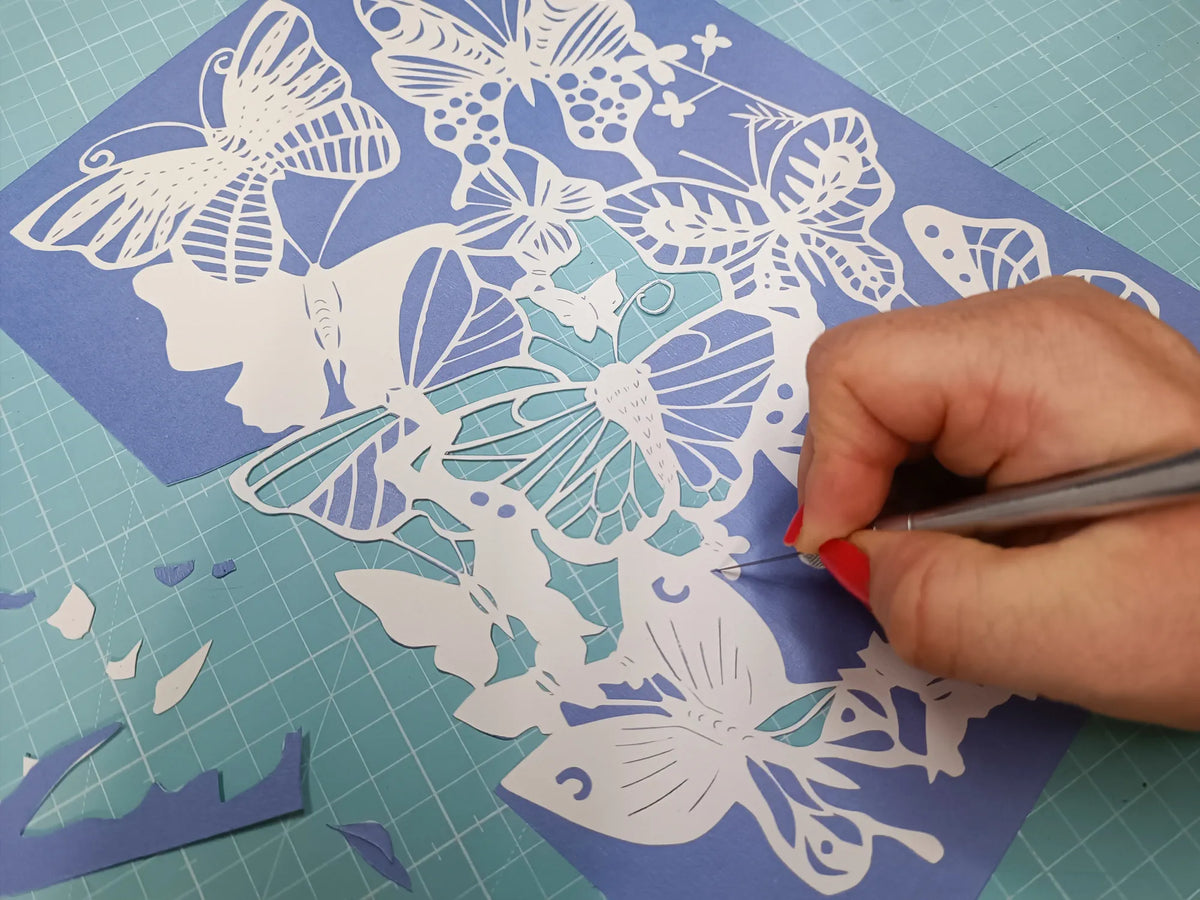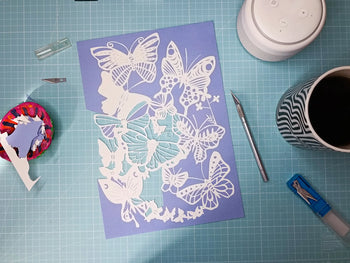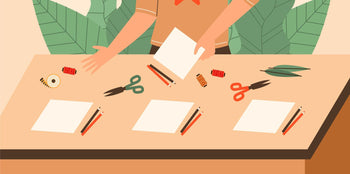

Do you have to be very precise to do Papercutting?
Yes, it helps, but don’t panic: the models are designed for beginners. The more time you take, the better the result will be.
What materials do I need to start?
You will need a printed template, a precision Papercutting knife, a cutting mat (self-healing type), and patience!
Is it complicated if I am not handy?
Not at all! This tutorial is designed for complete beginners. Just follow the steps calmly, without putting pressure on yourself.
What if I have never used a cutter?
No worries. The tutorial explains the right gestures, and you can practice on a scrap piece of paper before starting.
I’m afraid of messing up if I cut badly…
It’s normal! But every mistake can be fixed or integrated into the final result. It’s the whole that counts, not perfection.
How much time should be planned?
For a first time, allow 30 to 45 minutes. It’s a moment of calm, almost meditative — not a race!
Discover Papercutting in video
Summary: Explore this Papercutting tutorial
Introduction: Why try Papercutting?
Are you looking for a calming and original craft activity? Papercutting, or the art of paper cutting, is an excellent way to start a new creative hobby. With little material and great creative freedom, it is suitable for all levels.
This tutorial is intended for those who want to start making their very first Papercutting, with practical advice and tips to avoid common mistakes.
To conclude this important article, I hope it can evolve with your feedback and comments. In this regard, you will find at the very bottom a space to leave a comment on this article. Feel free also to come and chat in the Cardamine Papercutting community on Instagram or Facebook for advice or opinions!
1. Summary at a glance
Papercutting, a true DIY activity, invites you to create unique works with paper. Here is what you will discover:
The basic equipment to start.
Key steps for a successful Papercutting.
Advice to avoid common mistakes.
Ideas and tips to go further in this creative universe.

2. The steps to create your first Papercutting
a) The necessary equipment for this creative hobby:
To get started well, you will need a few simple tools:
- Precision cutting tool : a scalpel-type cutter is ideal.
-
Cutting mat: protect your work surface and facilitate cutting. Choose a mat suitable for the size of your models.
- A Papercutting Template : Choose a simple design to start.
Start Papercutting with a tool kit like this one. It includes all the necessary tools for practicing Papercutting!
Then choose a beginner model among all those offered in the shop:
💡 Tip:
Je vous propose un kit de démarrage au format A4 si vous souhaitez ne pas vous tromper. Investissez dans des lames de rechange pour garder your clean and precise cut. You will need to change it regularly, so remember to always have some in advance so as not to not to run out at the wrong time :)
b) Model preparation
- Choose a model from the shop or print your own model: Choose a pattern suitable for beginners, with simple lines and few fine details.
- Fix the paper: Use a light repositionable tape to hold the model on the thick paper.
- Plan your cuts: Start with the inner areas before cutting the edges. Take a break and think about what you want to do next.


c) The cutting technique
When you start cutting, it is important to press lightly on the tool.
Rather than forcing, let the blade glide naturally over the paper.
By adopting a smooth and relaxed gesture, you will not only avoid damaging the paper, but you will also achieve clean and precise lines.
This gentle movement is essential for neat work. For more precision, take the time to work in small sections.
Rather than trying to cut large areas at once, focus on smaller parts.
This approach will allow you to better control your movements and succeed in delicate details, without rushing.
Finally, to follow curves with ease, think about turning the paper rather than moving your hand ( see the video below "Papercutting a circle" ).
This technique offers you greater freedom of movement, prevents twisting your wrist, and guarantees harmonious and fluid curves.
By guiding the blade while handling the paper, you will add extra finesse to your creations.
Here is the detail of a cut
Many of you ask me how to proceed in case of a circular cut, here is an example.


💡 Tip: Use the tip of the blade to get rid of the cut piece (see the videos). For cutting rounded shapes; make a cut, then turn the subject, make another cut, turn the subject again. It is better to break down the cutting of the complex shape into several times rather than twisting your hand, the result will be better.
d) Showcasing the Papercutting
Once your Papercutting is finished, it's time to showcase it:
- Frame it under glass to protect it.
- Attach it to a colored background to create contrast.
- Create your own background; printed, cut, painted, drawn, a photo, you choose!
- Use it as a decorative element: greeting card, garland, or hanging decoration, on the wall, on furniture... The possibilities are endless.
Here is the "Gingko" model once completed and framed.
3. Important points not to overlook
- Safety first: When working with a cutter, safety is paramount. This tool, although precise and essential for Papercutting, can be dangerous if not handled carefully. Always make sure to work in a secure space, keeping the tool out of reach of children or anyone unfamiliar with its use. Also remember to store the blade as soon as you have finished, to avoid any accident.
- Concentration and patience : Papercutting is an activity that requires calm and attention. Settle in a well-lit space where you can clearly see the lines and details of your pattern. A calm environment will help you maintain your concentration, as rushing or distractions can harm the precision of your cutting. Take your time, as every move counts to achieve a flawless result.
- Paper choice: The type of paper you choose plays a crucial role in the success of your project. Paper that is too thin, although pleasant to handle, can tear easily under the blade, thus compromising your work. Opt for paper of intermediate thickness, strong enough to withstand cutting while remaining flexible. This choice will ensure both durability and finesse in your creations.
💡 Tip: Don't hesitate to wear safety glasses (like DIY glasses) this can prevent a piece of blade that broke off from hitting your face. If you are tired, take breaks or stop and resume later, this can help you avoid an accident with the blade.
4. Small practical info to know
- Time required: Before starting a project, it's useful to know how much time to dedicate. For a simple model, plan about 1 to 2 hours. This time includes not only cutting but also preparation and setup. By taking the necessary time, you can fully enjoy the experience without feeling rushed. More complex models can keep you busy for several hours!
- Starting budget : Papercutting is an accessible activity, even with a small budget. To equip yourself with basic tools, such as a precision cutter, a cutting mat, and some sheets of paper, expect to spend between 20 and 30 €. This initial investment will allow you to start under good conditions and fully enjoy your new passion.
- Inspiration: If you're looking for ideas to start, Pinterest is a goldmine. You will find a multitude of models, many of which are free and suitable for beginners. Whether you like simple shapes or more elaborate patterns, these resources will help you find inspiration for your first projects.
- Storage: Take care of your tools by storing them properly after each use. A storage pouch or a small dedicated box is ideal to prevent your accessories from getting damaged or you from getting injured. This will help extend their lifespan and make them easy to find for your next creations. To protect your models, there are drawing boards of all sizes that allow you to store them without risking damage.
5. Common mistakes to avoid
- Choosing a model that is too complex: Avoid being too ambitious when you start! It's better to multiply easy models to gain dexterity, then move on to more complex models.
- Neglecting blade sharpness: A dull blade is your worst enemy. Not only can it tear the paper, but it can also make cutting more tiring and less precise. Change your blade if the tip breaks.
- Going too fast: Papercutting requires patience. Rushing your movements can compromise the final result and cause mistakes! Take your time to ensure clean and neat lines.
- Pressing too hard on the cutter: Apply light and steady pressure. Pressing too hard on the tool can not only damage the paper but also increase the risk of injuries and blade breakage.
Conclusion and inspirations:
You are now ready to dive into the world of Papercutting, a creative hobby accessible to all and relaxing. I advise you to start with simple projects and then increase the difficulty as you gain confidence. Finally, let your imagination run free to showcase your creation.
📌 Want to go further? Discover my models specially designed for beginners and add a personal touch to your decoration or gifts.
And you? What will be your first Papercutting project? Share your ideas or creations on my Instagram or in the comments!
what to do when you're bored?







